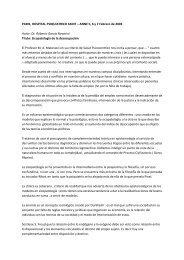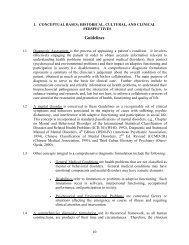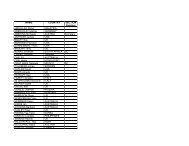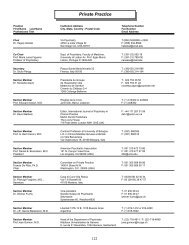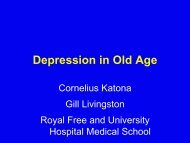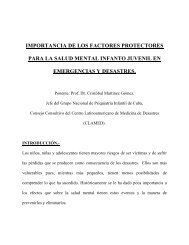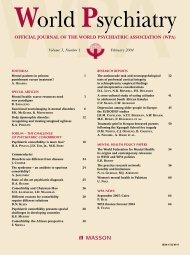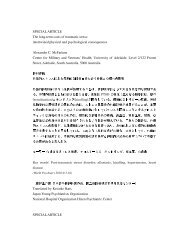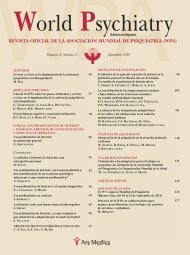ABSTRACTS - World Psychiatric Association
ABSTRACTS - World Psychiatric Association
ABSTRACTS - World Psychiatric Association
Create successful ePaper yourself
Turn your PDF publications into a flip-book with our unique Google optimized e-Paper software.
SPS5.2.<br />
SCIENTIFIC RATIONALE FOR WHAT WE OBSERVE<br />
IN THE CLINIC<br />
G. Gründer<br />
Department of Psychiatry and Psychotherapy, University<br />
of Aachen, Germany<br />
Knowledge of the receptor-binding profiles of antipsychotics can help<br />
optimise the efficacy and safety of treatment. For example, activity at<br />
dopamine receptors plays a role in psychosis, while activity at serotonin<br />
receptors is associated with impact on mood, cognition and anxiety<br />
symptoms. High-affinity dopamine D 2<br />
receptor binding and slow<br />
dissociation, however, may lead to extrapyramidal symptoms and<br />
hyperprolactinaemia. Activity at other receptors, such as histamine H 1<br />
,<br />
muscarinic and a-adrenergic receptors, may also be associated with<br />
adverse events. Attention should be paid to the pharmacokinetic implications<br />
of the route and mode of administration (oral, intramuscular or<br />
long-acting). While short-term adverse events may be associated with<br />
mode of administration, there is no evidence for different long-term tolerability<br />
profiles. In patients who experience side effects, appropriate<br />
short- or long-term co-medications should be added. Switching from<br />
one antipsychotic to another may be desirable, such as in the event of<br />
insufficient efficacy or unacceptable safety issues, such as weight gain.<br />
Switching medication may, however, be associated with amplified or<br />
muted treatment effects, hangover effects relating to the half-life of the<br />
previous agent, and adverse events relating to receptor up-regulation.<br />
Switching must therefore be carried out according to appropriate psychopharmacological<br />
principles, with a clear understanding of the pharmacokinetic<br />
profiles of the agents involved (e.g., by cross-titration with<br />
appropriate titration strategies). Balancing efficacy and tolerability is<br />
essential in patients receiving antipsychotic medication, and careful<br />
attention to the receptor-binding and pharmacokinetic profiles of the<br />
different agents can minimise adverse events and improve outcomes.<br />
SPS5.3.<br />
THINKING LONG-TERM FROM THE START<br />
M. De Hert<br />
University <strong>Psychiatric</strong> Centre, Leuven Catholic University,<br />
Kortenberg, Belgium<br />
Compliance with antipsychotic therapies in patients with severe mental<br />
disorders is a major concern for clinicians. The need for long-term<br />
antipsychotic treatment may be challenged if a patient has difficulty<br />
accepting the prospect of life-long administration or has concerns<br />
over the potential adverse events (AEs) associated with antipsychotic<br />
drugs. The early onset of AEs, such as akathisia or agitation, may<br />
increase the likelihood of poor long-term compliance by encouraging<br />
patients to self-manage. This can lead to treatment discontinuation<br />
and/or poor adherence, which may result in reduced efficacy and<br />
negatively impact the long-term prognosis. People with severe mental<br />
disorders often have impaired physical health. This may be related to<br />
their lifestyle, their difficulty accessing healthcare services or to side<br />
effects of antipsychotic medication. Reduced physical health is linked<br />
to drug-induced hyperprolactinaemia, and to an increased prevalence<br />
of weight gain, diabetes and dyslipidaemia. These latter metabolic disturbances<br />
have been shown to increase a patient’s risk of developing<br />
cardiovascular disease, with potentially serious consequences. The<br />
propensity to cause metabolic disturbances varies between antipsychotic<br />
agents and data suggest that the unwanted metabolic effects of<br />
some antipsychotics may be reversed by switching to an agent with a<br />
more favourable side effect profile. Considering the concern over<br />
compliance with antipsychotic therapies and the risk of metabolic<br />
disturbances, it is important to provide a therapeutic agent that is<br />
effective at treating the symptoms of the mental disease and does not<br />
further impact on the physical health of the patient from the outset of<br />
the illness.<br />
SPS6.<br />
AGOMELATINE: OPTIMIZE THERAPY FOR ALL<br />
DEPRESSED PATIENTS<br />
(organized by Servier)<br />
SPS6.1.<br />
CIRCADIAN RHYTHMS: STRONG EVIDENCE<br />
ON HOW TO APPROACH DEPRESSION<br />
E. Frank<br />
Western <strong>Psychiatric</strong> Institute and Clinic, University of Pittsburgh<br />
School of Medicine, Pittsburgh, PA, USA<br />
Although life in industrialized society masks endogenous circadian<br />
rhythms that were more apparent centuries ago, circadian rhythm regularity<br />
and synchrony have great importance for all aspects of human<br />
health and well-being. Indeed, our knowledge of this relationship<br />
grows almost daily, with evidence that everything from organ systems<br />
to gene products benefit from circadian integrity. Our research group<br />
has focused on the relationship of circadian regulation and psychiatric<br />
illness, particularly mood disorders. Nearly 20 years ago we articulated<br />
a “social zeitgeber” hypothesis concerning the way in which<br />
life events that disrupt an individual’s normal routines could initiate a<br />
cascade that, in vulnerable individuals, might lead to an episode of<br />
depression or mania. Since that time we have developed two lines of<br />
evidence in support of this hypothesis. First, we demonstrated that life<br />
events characterized by social rhythm disruption are temporally associated<br />
with onset of mood episodes. We subsequently demonstrated<br />
that a psychotherapeutic intervention which specifically targets regularizing<br />
of daily routines is associated with the prevention of both<br />
manic and depressive episodes and that the protective effect of the<br />
treatment is directly related to the extent to which patients increase<br />
the regularity of their social rhythms. More recently, this same intervention<br />
has been shown to be associated with recovery from bipolar<br />
depression and significant improvement in occupational function. We<br />
discuss the implications of these findings for the treatment of all<br />
depressions.<br />
SPS6.2.<br />
PHARMACOLOGICAL PROFILE OF AGOMELATINE:<br />
THE FIRST MELATONERGIC ANTIDEPRESSANT<br />
G. Racagni<br />
Center for the Study of Neuropharmacology, University<br />
of Milan, Italy<br />
Beyond the classical monoamine hypothesis, which has limitations, a<br />
variety of research approaches have been followed to obtain more<br />
effective treatments for depression, with better safety profile and more<br />
rapid symptoms relief. Among these approaches, the regulation of circadian<br />
rhythms in mammals has attracted growing interest, because<br />
the disruption of circadian rhythms is now well described in<br />
depressed patients, suggesting that the human circadian system is a<br />
key player in the etiology and in the treatment of mood disorders. This<br />
led to the synthesis of agomelatine, an agonist with high affinity for<br />
melatonergic MT 1<br />
and MT 2<br />
receptors, and antagonist at 5-HT 2C<br />
receptors. As expected from its pharmacological profile, agomelatine<br />
was able to synchronize circadian rhythm patterns in several animal<br />
303




